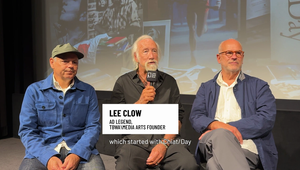
King Tuts: LIA Legend Mark Tutssel Urges Creatives to Embrace Curiosity and Do Their Homework

Is there anyone who loves creative advertising more than Mark Tutssel? At home, he keeps a vast collection of historic award show annuals, with volumes so rare that the original award shows don’t own copies. Throughout his career, he has pored over these tomes countless times, absorbing the very best work from his contemporaries and creative forebears. He can tell you in an instant if an idea has been done before. As a young man, he and his creative friends would play a game of ‘name the page number’, where someone would list a campaign and the rest would have to guess its corresponding page number from the annual - and the creative team, strategist, illustrator, director…
These days, Mark is retired. But he’s an eternal student, constantly refreshing and adding to his encyclopaedic knowledge of creativity. His intense appreciation for great creative work is matched only by his ceaseless curiosity and profound sense of duty to help up-and-coming generations of creatives to reach their full potential.
And this week, Mark’s devotion to creativity and creatives has been recognised by the London International Awards (LIAs). They have bestowed on him the Created for Creatives LIA Legend Award in recognition of everything he has done for the industry. At the LIAs himself, he came up with the Creative LIAisons Virtual Coaches programme, which sees up-and-comers paired with top chief creative officers for one-to-one coaching.
If there’s one piece of advice that the former global CCO of Leo Burnett wants the next generation to absorb it is simply this - to embrace curiosity and to be sponges for creativity.
“If you don’t have curiosity sitting at the heartbeat of you as a creator, then I don’t think you will ever realise your true potential,” he says, deeply serious. “I don’t think that you will ever step outside of the norm and produce something that’s fresh, that’s different, that expresses a brand story in a new way.”
That means being relentlessly hungry to learn about creative advertising, to hunt down and learn from the very best work and to build up a knowledge bank of the great canon of advertising’s best work and greatest talents from around the world.
“The more you understand the subject matter, the more knowledge you have, I think the more equipped you are to then write and create original content that will stand out in a particular space,” he says.
At first glance, this might sound like someone who looks back to the past, but nothing could be further from the truth. Mark delights in the truly original and, thanks to his own ceaseless curiosity, he is keenly aware of the realities and new opportunities available to creatives in 2023. Those who do their homework and know their history will find that they have a greater internal resource that they can draw from instantly. Having a broad knowledge of advertising’s past - as well as a good general knowledge and curiosity about the wider world - will allow creatives to respond in real time to emerging opportunities with true speed and agility.
“That content creation is very different from the halcyon days. I’m talking about where we had the time to craft, to think, to experiment, to develop, to prototype, to create different variants and really investigate the full potential of an idea before we presented it. We had a lot of time to think things through to the nth degree,” he says. “Now, time is the enemy. There’s a lack of time, and the speed and agility that you need to conceive and create in a nanosecond is becoming a vital art form. But the thing that’s missing is the consistency of message and consistency of meaning, and the clarity of that.”
And while the demands facing creatives are intense, as they juggle a constant barrage of new platforms, social media conversations and a demand to be on top of them all, Mark reckons that the ambitious and passionate will still make space to learn and study, to watch greats like VW’s ‘Snow Plow’ or Coca-Cola’s ‘Hilltop' or Cadbury’s ‘Gorilla’. Or, to tip the hat to the great work that Mark himself has been involved in; John West’s ‘Bear’ or Always’ ‘Like a Girl’.
Above: Leo Burnett UK's 'Bear' for John West
“Obviously they’re under a lot of pressure. But I think you have to do your own personal homework behind the scenes. Not in the day-to-day,” he says. “It’s not a job. This is a passion. This is absolute. I mean, I’m religious about it. I’m so interested because it gives me such joy to know about things and to discover great ideas.”
This curiosity and an arsenal of creative knowledge will also give creatives the ability to be truly original. In an age where everyone’s chasing trends, this foundation can empower creatives to create the trends.
“Borrowed interest is the easiest thing in the world to do. Not only today, it’s been around forever,” he reflects. Of course, that’s not always a bad thing - where there’s a real fit it can be incredibly powerful. Hamlet’s ‘Photobooth’ branded comedy sketch and Honda’s appropriated Rube Goldberg artwork in ‘Cog’ perfectly align with the brand platform and message. It can, though, become a crutch that fails to deliver, whether it’s a brand clumsily jumping on a TikTok trend or a poorly considered celeb endorsement.” A lot of times we graft brands onto things that are interesting in popular culture, and try to glue them together when there’s no correlation between the two. There’s no fit. There’s no real reason to be together, it’s just an interesting execution!”
He tells a story from when he first moved to Chicago to become Leo Burnett’s global creative leader. His precious collection of annuals lined the walls of his office. He quickly got rid of the layers between himself and the working creatives, telling them that anyone with a good idea was welcome to come to see him. Sometimes a great idea would send him shooting from his chair, to the shelves where he’d select an awards annual, open it to the exact page and show the hopeful creatives… that the idea had already been done. But this was done not to shame the creatives but to encourage them - while they would not be able to pursue this idea, the fact it had been previously awarded showed that they were indeed capable of coming up with award-winning ideas. And it’s an approach that saw Leo Burnett shoot up the creative rankings to become a top three creative agency in his first two years.
But when it comes to that hunger to learn and furnish oneself with knowledge, Mark urges creatives to apply that to their clients too. Voraciously researching the client, their competition and the wider landscape should be a creative’s first port of call. Mark recalls working on Mercedes Benz and carefully unpicking all of the other brands and what they stood for in the space and how consistently those brands applied that meaning. Or, reflecting on Johnnie Walker’s ‘Keep Walking’ platform from his friends at BBH, he recalls that all whisky brands at the time were about cosy fireplaces, heritage and provenance. Johnnie Walker’s history of innovation (square bottles, anyone?) meant it could happily claim a new space in the category: progress. A quick flip of the jaunty gent in the logo, and the rest was history.
“Knowledge is king, and I honestly believe that creativity is the logical conclusion of brilliant thinking. The more time you spend thinking about a subject, the more time you dive deep… [the more you are] aware of what the public is seeing and consuming,” says Mark. “I’m always looking for what the truth is about that brand and what truth I can build a platform and then campaign on. So, my fascination is with great ideas. It’s fuel for creativity. It’s inspirational. It sets the bar. It’s a standard that you have to better.”
The thing about the diversity of business challenges that a creative might come across is that you never know when a nugget of knowledge might come in handy. So, while Mark’s a fastidious student of advertising, he also has passion for design and architecture, all of which goes to make his knowledge bank even richer.
Mark is urgently keen for young creatives to give themselves a fighting chance. It’s his great joy in life to see others succeed. He recalls the great British copywriter David Abbott telling him that ‘flowers bloom in the sunshine’. He explains, “You have to create an environment where people believe they can do the best work of their lives. People blossom when they feel free to express themselves and to grow and evolve their ideas. As long as you’re supporting brave thinking… I’m all for backing failure, allowing people to fail and then move onto the next level.”
He beams with pride as he lists off the ‘Burnetters’ who he helped bloom: Tor Myhren, Susan Credle, Andy DiLallo, Bechara Mouzannar, Pancho Cassis, Judy John… and his pride is greater still when he sees them passing on that same care and nurture to the generations coming up under them.
Above: Always' 'Like a Girl', created under CCO Judy John
“I’ve had the pleasure of working with all these people and they’ve all gone on to do bigger and better things. They are really amazingly talented people doing great work again, and under them are great people. I love this - watching people grow and get better and better and better,” he says. But this isn’t just about his own lasting legacy, it’s far more generous. “I’m obviously inextricably linked to Leo Burnett, but I’m also known as somebody who cares about the industry as much as I do Leo Burnett. In fact, I care about the people in the industry and the work in the industry more than anything and I don’t really care who’s successful as long as a spotlight is shone on the work that is best in class."
It’s those deeply held values that have earned Mark - or ‘Tuts’ as he’s known to friends - such affection. One year, when he was attending an event to help young creatives, a friend created a specially branded tin of metal polish for him to dish out. ‘King Tuts' Metal Polish’ featured Mark as King Tutankhamun - the cheeky fine print read ‘doesn’t work on silver or bronze, only works on gold’, reflecting Mark’s single-minded focus on the very best of the best.
Of the honour he’s received this week, he says, ‘it’s very humbling’. He’s never been interested in personal glory, with his tunnel-vision on great work. But nonetheless, as he received the award from the LIA’s CEO Barbara Levy, Mark was clearly moved by the recognition of all he has done.
“I’ve never been a creative that seeks the limelight. When I first started, the one thing I would never do was call the press - to the horror of Leo Burnett… And I said, there are two types of creative people. There are the narrators and then there are the creators. There are a lot of people who talk about the industry and their theory on the industry, and then there are the people who quietly do the work. Everybody I really admire has just done the work. Dan Wieden, David Abbott, John Salmon - look at the best work of John Webster at BMP. They’ve all managed to just produce great work and let the work do the talking. So, my philosophy has always been: if you produce great work, people will write about great work, because they have to.
“My sole purpose is to produce great work, my sole purpose is to coach great work, my sole purpose is to get the best work out of people.”















